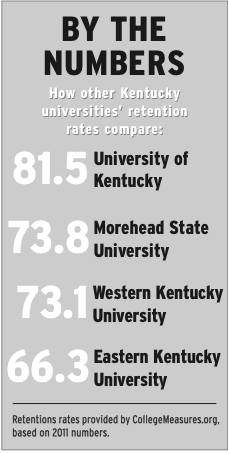Retention rates at Murray State have been increasing since 2012 and an even higher number for the 2013-14 school year may be in store.
Rates are up from 70 percent to 72.6 percent, and the retention rate for 2013-14 will be reported after the close of the academic year.
These numbers are based off how many students stay enrolled from their first fall semester to their second fall semester, and the office of retention has been working on improving numbers by promoting the MAP-Works survey.
After Jamie Mantooth became the director of the office of retention in April 2012, MAP-Works was developed as an online retention platform designed to help identify at-risk undergraduate students early.
By taking the survey, Mantooth can identify what problems students have in and out of the classroom.
“We’re looking to see if there is an out of the classroom factor that is affecting inside the classroom behavior, because most of the time it is not really an academic issue,” Mantooth said. “If there’s a roadblock that has come up, then how can we address that and what is going on?”
He said the biggest issue students have is homesickness, followed by financial issues and difficulties transitioning from high school to college.
Student involvement on campus can help make the adjustment to college easier by distracting students from homesickness they may experience.
Mantooth said he believes involvement is also important in helping students return to campus, and involvement ranges between multiple facets of campus life.
“Involvement is anything from being in a fraternity, running for an Student Government Association office, being on your RCC board or attending a basketball game,” he said. “Those are all forms of campus involvement.”
While Mantooth said people can automatically default involvement to Greek Life or SGA, even eating at Winslow Dining Hall is being involved.
Catherine Hunt, sophomore from Cincinnati, said her involvement has kept her on campus and is a factor in her decision to not transfer from Murray State.
“I’ve been very involved in Elizabeth Residential College and I’ve formed a family of sorts here,” Hunt said. “I have thought about transferring maybe a little right after I moved in freshman year but once I started getting involved and getting to know people, I have been fine.”
She said she believes getting involved is a key part of students getting to know each other and making friends.
“For the most part, there is ample opportunity for involvement on campus,” Hunt said. “You just have to know who to ask to find out if there’s a club.”
Administration and student say the University can also make a few changes to help improve retention rates, despite the recent progress in increasing numbers.
When President Tim Miller first joined Murray State’s community for his undergraduate degree, he said retention rates were not the best.
However, since he’s returned, he believes focus has been shifted back to keeping students on campus when they arrive and changes can always be made in keeping them.
“We need better advising and that always helps,” Miller said.
However, Miller also said students should become more aware of their programs and what they want to do during their time at college.
While students can speak to Mantooth and other University staff and faculty available to help with out-of-classroom problems, professors can also notify the retention office through referrals if a student has shown consistent problems in class.
“If faculty members notice a pattern of behavior in students that might be a point of concern, they can log into MAP-Works, send us an electronic form and then we reach out to the student to find out what we can do to help,” Mantooth said. “The whole point is to address a small issue before it becomes a big issue.”
He said the top two reasons the retention office gets referrals is excessive absences and academic performance.
From the beginning of MAP-Works, the retention office has received about 1,500 referrals. They are now receiving about 1,200 referrals, but official numbers will not be reported until the end of the school year.
The professor referrals are designed to help extend retention efforts as far as possible and allow for professors to get students the help they need if they are struggling.
Mantooth said: “All those (referrals) are instructors and staff members that are concerned about their students, which I think is a real hallmark for the University because the instructors are noticing their students.”
Story by Mary Bradley, Assistant News Editor